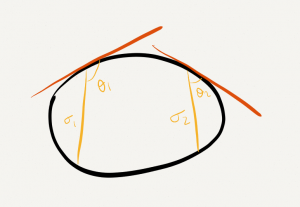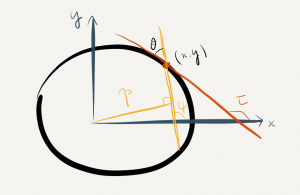This note is based on Nicolas Garcia Trillos’ talk, Some Problems and Techniques in Geometric Probability, at Carnegie Mellon University on January 29, 2015.
In particular, we demonstrate a probabilistic proof of the isoperimetric inequality. The proof can also be found in Integral Geometry and Geometric Probability by Luis A. Santaló.
Theorem. For a convex set with perimeter L and area A, the isoperimetric inequality states that 4\pi A\leq L^2, and that equality holds if and only if the convex set is a disk. (Assume that the boundary is a closed convex curve of class C^1.)
Proof. Let P(s) parametrize the boundary by its arc length s. Given s and \theta. Suppose the line through P(s) whose angle to the tangent line equals \theta intersects the boundary at another point Q(s). Let \sigma(s, \theta) be the length of the chord between the two intersections P(s), Q(s). Consider the integral \int (\sigma_1\sin\theta_2 - \sigma_2\sin\theta_1)^2 \mathrm{d}s_1\mathrm{d}\theta_1\mathrm{d}s_2\mathrm{d}\theta_2, where the integration extends over 0 \leq s_1, s_2 \leq L and 0 \leq \theta_1, \theta_2 \leq \pi.

Expanding the square in the integrand, we obtain that the integral is equal to \pi L \int \sigma^2\mathrm{d}s\mathrm{d}\theta - 2\left(\int \sigma\sin\theta\mathrm{d}s\mathrm{d}\theta\right)^2.
On one hand, we have \int \sigma^2\mathrm{d}s\mathrm{d}\theta = \int_0^L\int_0^\pi \sigma^2\mathrm{d}\theta\mathrm{d}s = \int_0^L 2A\mathrm{d}s = 2LA.

On the other hand, let p be the distance from the chord to the origin and \phi the angle from the x-axis to the chord. Suppose the angle from the x-axis to the tangent line is \tau. We have p = \langle x, y\rangle\cdot\langle \sin\phi, -\cos\phi \rangle = x\sin\phi - y\cos\phi. Differentiating the latter, we get \mathrm{d}p = \sin\phi\mathrm{d}x - \cos\phi\mathrm{d}y + (x\cos\phi + y\sin\phi)\mathrm{d}\phi. Moreover, we know that \mathrm{d}x = \cos\tau\mathrm{d}s, \mathrm{d}y = \sin\tau\mathrm{d}s. Therefore \mathrm{d}p = \sin\phi\cos\tau\mathrm{d}s - \cos\phi\sin\tau\mathrm{d}s + + (x\cos\phi + y\sin\phi)\mathrm{d}\phi, and so \mathrm{d}p\mathrm{d}\phi = \sin(\phi - \tau)\mathrm{d}s\mathrm{d}\phi. Since \theta + \phi = \tau and \mathrm{d}\theta + \mathrm{d}\phi = \tau'\mathrm{d}s, we have \mathrm{d}p\mathrm{d}\phi = -\sin\theta\mathrm{d}s\mathrm{d}\theta, and so \int\sigma\sin\theta\mathrm{d}s\mathrm{d}\theta = \int_0^{2\pi}\int_{-\infty}^\infty \sigma\mathrm{d}p\mathrm{d}\theta = 2\pi A.
Since the integral is non-negative, we have that 2\pi A(L^2 - 4\pi A)\geq 0, and so 4\pi A \leq L^2. The equality is achieved if and only if \sigma / \sin\theta is a constant, in which case the boundary is a circle. [qed]
Remark. The proof is considered a probabilistic proof because the differential form \mathrm{d}p\mathrm{d}\theta is the measure (invariant under rigid motion) of a random line.
Cool! How did you draw those diagrams?
Thanks! I drew them via Paper on my iPad using a stylus.